When Hurricanes Fan the Flames: Could Hurricane Erin Spark a Gray Swan Wildfire Threat in Canada?
Frequent readers of these BMS Tropical Updates know that the value added comes from taking unique views, often ones that no one else in the industry holds. This is why in this update, we take a slightly different angle to Erin's forecast and discuss something that needs to be considered late next week.
There has no doubt been fear mongering, spamming, of fantasy long range forecast across Social Media with some impact to the NE Caribbean Island, Bermuda, Bahamas or any portion of the Eastern U.S. If your following a source that is promoting this type of content, you might want to consider looking elsewhere - like these BMS Tropical updates, which hasn’t disseminated anything outlandish this week, at least until the more unconventional topic discussed in the next section.
Overall, the long-range forecast model has been consistent over the last few days. As we discussed in the tropical update issued on Wednesday, August 13th, Erin would likely track west of Bermuda and East of the U.S. Coastline, with Bermuda having the greatest impact of seeing tropical storm force winds. The probability of any U.S. landfall remains very low, and the overall implications to Bermuda continue to decrease, with about a 30% chance of Erin tracking within 150 km of the insurance hub.
Erin will be tracking over some of the warmest water in the Atlantic basin, which is 30 °C or 86°F. Warm water is fuel for hurricanes, and it was suggested that Erin could become a category 4 hurricane, which the National Hurricane Center is now forecasting. One of the most significant changes in the forecast is that Erin could now become a Category 5 hurricane as it passes east of the Bahamas early next week. This is prime ground for other historical Category 5 hurricanes, and given the warm water and ideal atmospheric conditions Erin will be tracking into, this maximum potential intensity can’t be ruled out, but Erin should become a Category 4 hurricane as now forecasted northeast of the Bahamas.
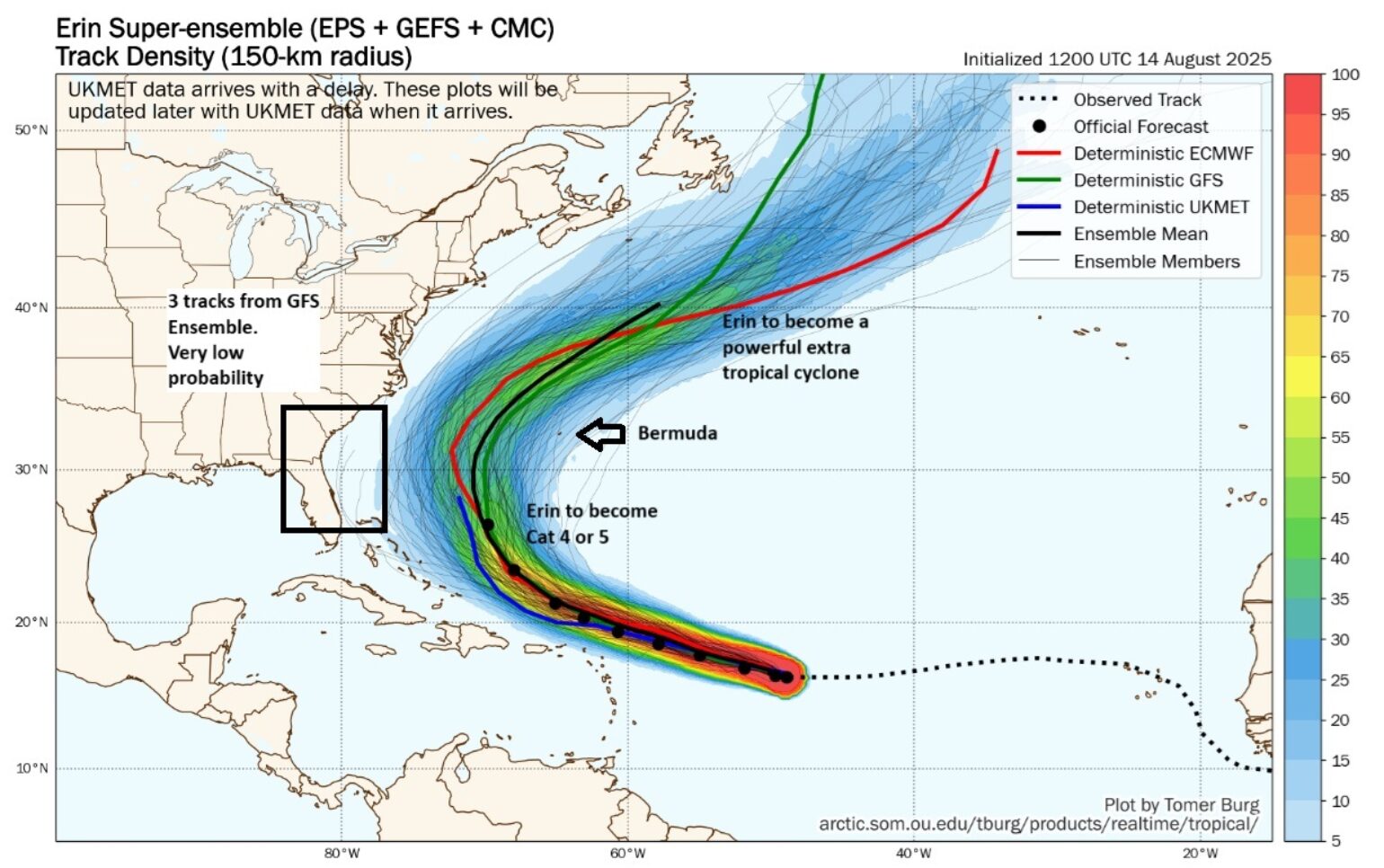
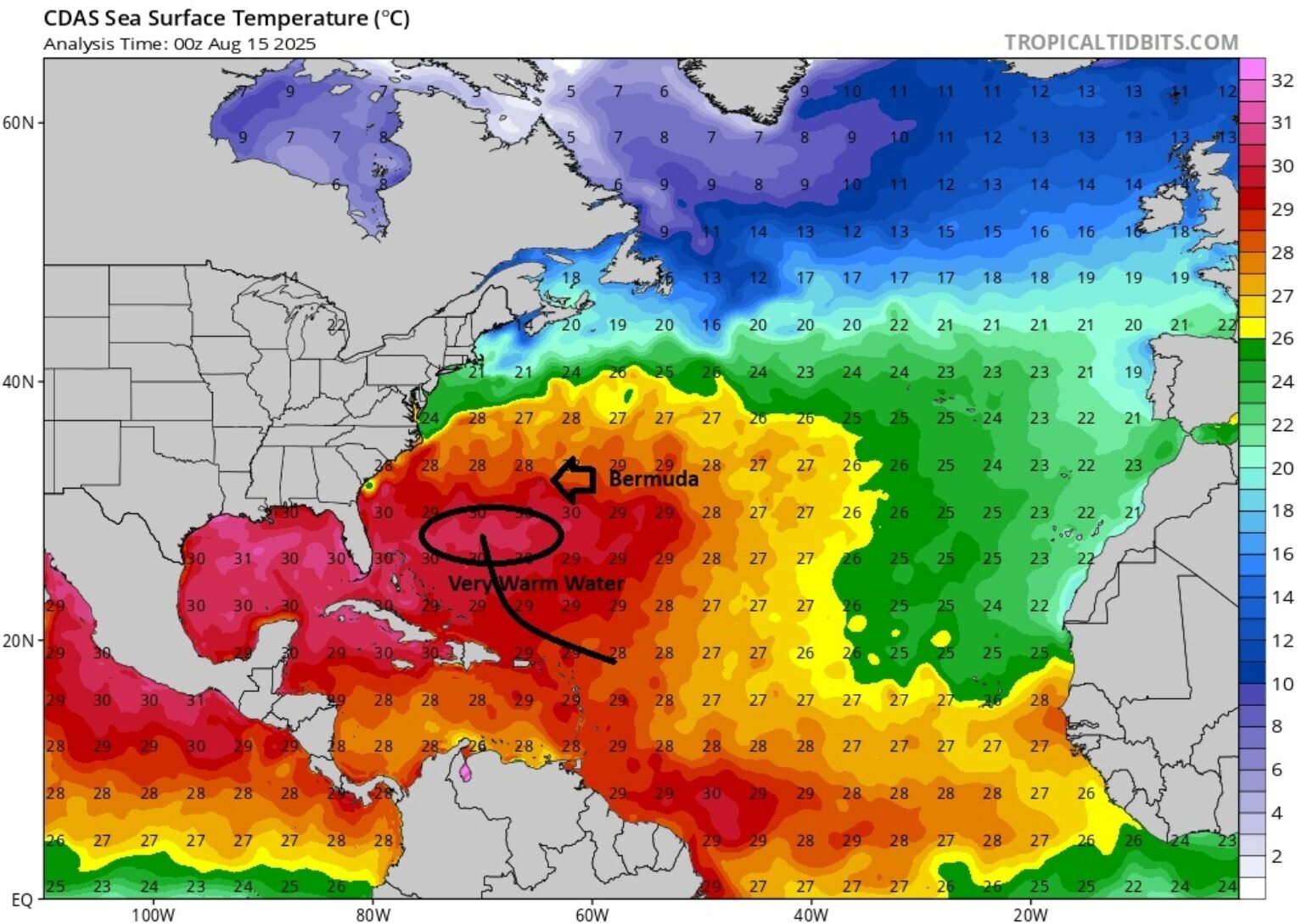
By Thursday and Friday next week, Erin could transition and phase with the upper-level low that is pulling the storm North between Bermuda and the U.S.. This interaction with the jet stream creates a powerful extratropical cyclone with an expanding wind field. Of course, the track into the North Atlantic is uncertain, with significant track errors. However, as the wind field expands, and if an extra-tropical storm Erin tracks closest to the Canadian Maritimes, it could create something unusual —a wildfire hurricane.
An Unusual Setup for Hurricanes and Wildfires:
When we think of hurricanes, our minds jump to wind damage, storm surge and torrential rain. When we think of wildfires, we picture tinder-dry forests, crackling flames and plumes of smoke rising into the summer sky. Rarely do we connect these two hazards — yet sometimes the atmosphere aligns in unusual ways, creating a compound threat.
Meteorologists and risk managers call these “gray swan” events: scenarios that are plausible and potentially high-impact, but rare enough that they aren’t part of our everyday hazard planning. As discussed above, there is a scenario where extra-tropical Erin could track closer enough to Atlantic Canada to raise the concern of such a possibility for Atlantic Canada, as Erin brings not floods, but instead winds that fuel a heightened wildfire risk.
Again, at this point, this is a hypothetical forecast as nothing in the current forecast suggests this could occur. We are currently uncertain about the projections for how Erin will skirt East of Atlantic Canada; specifically, we are unsure if the heaviest rainfall will be offshore. However, rain is needed across Atlantic Canada as it would provide relief to the high wildfire risk that exists.
In this hypothetical forecast, Erin’s storm track could create a tight pressure gradient between the hurricane offshore and high pressure to the west. That setup could funnel strong, dry winds across parts of Nova Scotia, New Brunswick, and Prince Edward Island. With the storm’s moisture shield mainly staying over the ocean, those winds would arrive without the soaking rains that would usually dampen fuels and lower fire danger.
Three Ingredients for a Dangerous Wildfire Day
Wildfire behavior boils down to a mix of three ingredients: fuels, weather, and ignition sources.
- Dry Fuels – Atlantic Canada has faced unusually dry conditions this year, with below-average rainfall and above-average temperatures in recent weeks. Grass, shrubs and forest litter are all at critical dryness levels, meaning they can ignite and spread flames quickly. Below is a look at the current wildfire danger across Atlantic Canada, with parts of Nova Scotia having High to Extreme wildfire risk from August 12th.
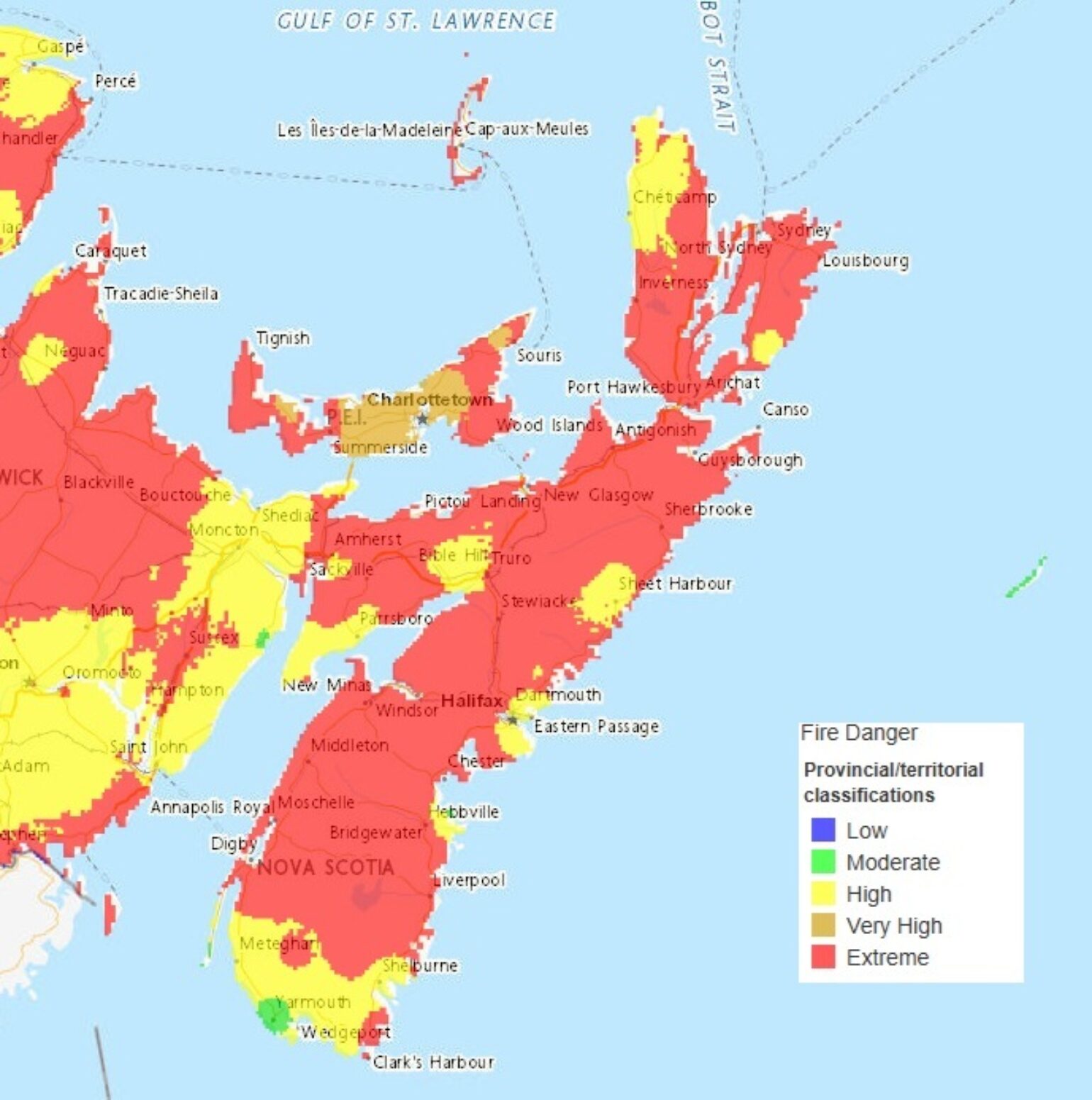
- Wind – Strong winds are the great wildfire accelerators. They dry fuels even further, push flames forward at alarming speeds and loft embers far ahead of the fire front, creating new ignition points. A hurricane passing offshore can generate sustained winds over a large area, an unusual driver for wildfire spread in this region.
Below is the current forecasted wind field from the ECMWF model, showing that as Erin passes Nova Scotia, strong offshore winds could reach 50 knots or about 60 mph, enough to accelerate a fast-moving wildfire.
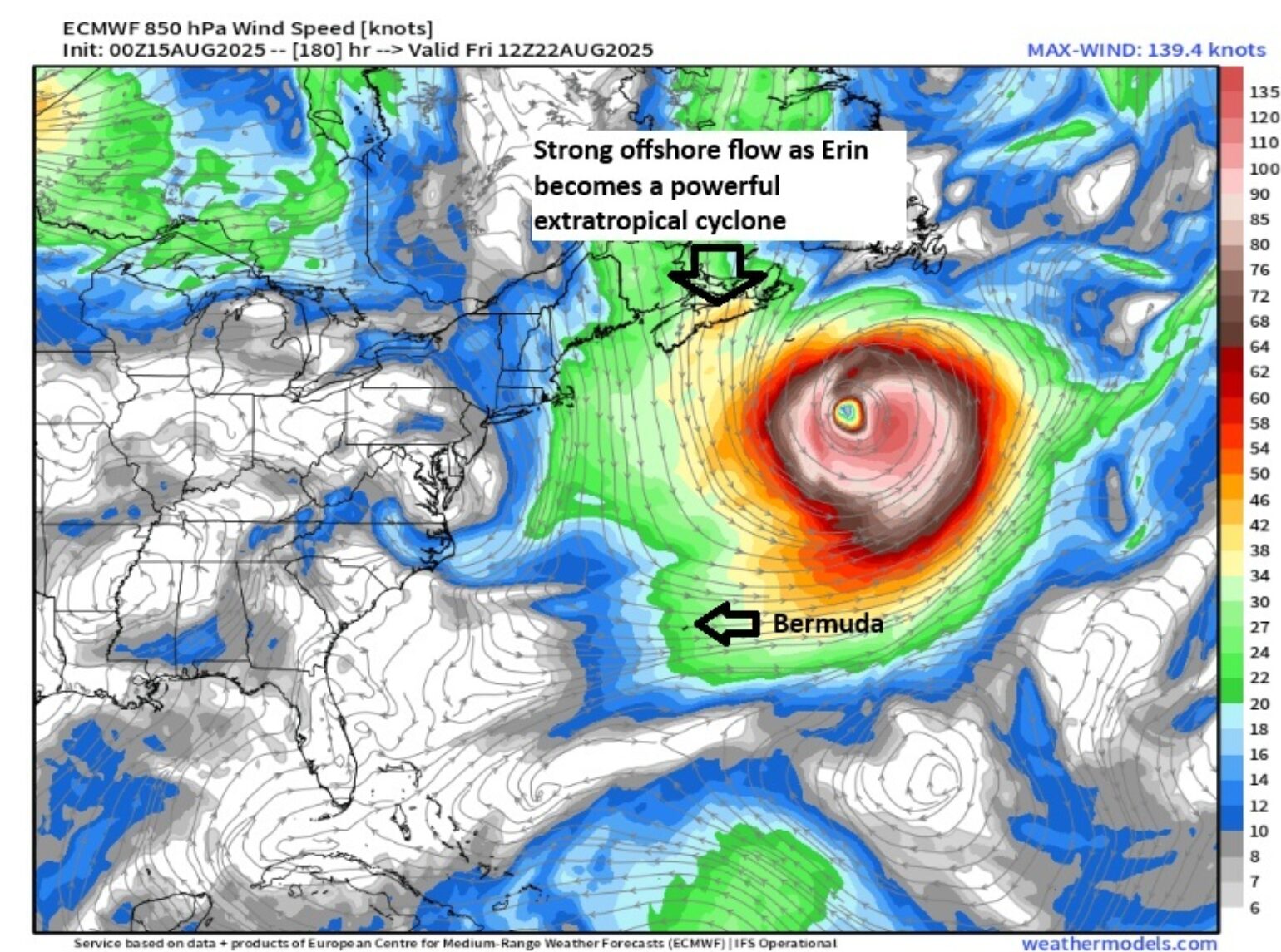
- Human Activity – The majority of wildfires in Canada — more than 60% — are caused by people. In times of extreme dryness and strong winds, a single spark from a backyard burn, a downed power line or even improperly discarded smoking materials can turn into a rapidly spreading blaze. Fire restrictions are already in place. The government of Nova Scotia has closed all woodlands across the province due to extremely high wildfire risk. Telling everyone to “STAY OUT OF THE WOODS,” Violators will be issued a $25,000 CD fine. It has been reported that fines in Newfoundland and Labrador could be as high as $50,000 CD to $150,000 CD. This is, of course, all for good reason because any lapse in vigilance during a windy day could have outsized consequences.
Hurricanes and Wildfires: Rare, But Not Unprecedented
While this combination might seem unlikely, history shows that tropical cyclones have, at times, played an indirect role in worsening wildfire conditions.
- Hurricane Dora (Hawaii, 2023) – The insurance industry doesn’t have to go back far to understand the connection between hurricanes and wildfires. While Dora itself remained well south of Hawaii, its powerful winds interacted with high pressure to the north, producing intense, dry gusts across Maui. Combined with already parched vegetation, those winds helped drive the catastrophic Lahaina wildfire that claimed over 100 lives and about $4B in insurance losses.
- Hurricane Lane (Hawaii, 2018) – Even as Lane brought torrential rains to parts of the islands, its outer bands produced strong, dry downslope winds in leeward areas. Fires in Maui and Oahu flared up and spread rapidly under these wind conditions.
- Typhoon Hagibis (Japan, 2019) – Ahead of Hagibis’s landfall, dry northerly winds fanned several large wildfires in Japan’s Chiba Prefecture, a reminder that cyclonic wind fields can affect fire spread even before rain arrives.
These examples show that cyclones can act as fire catalysts when they overlap with pre-existing dry conditions.
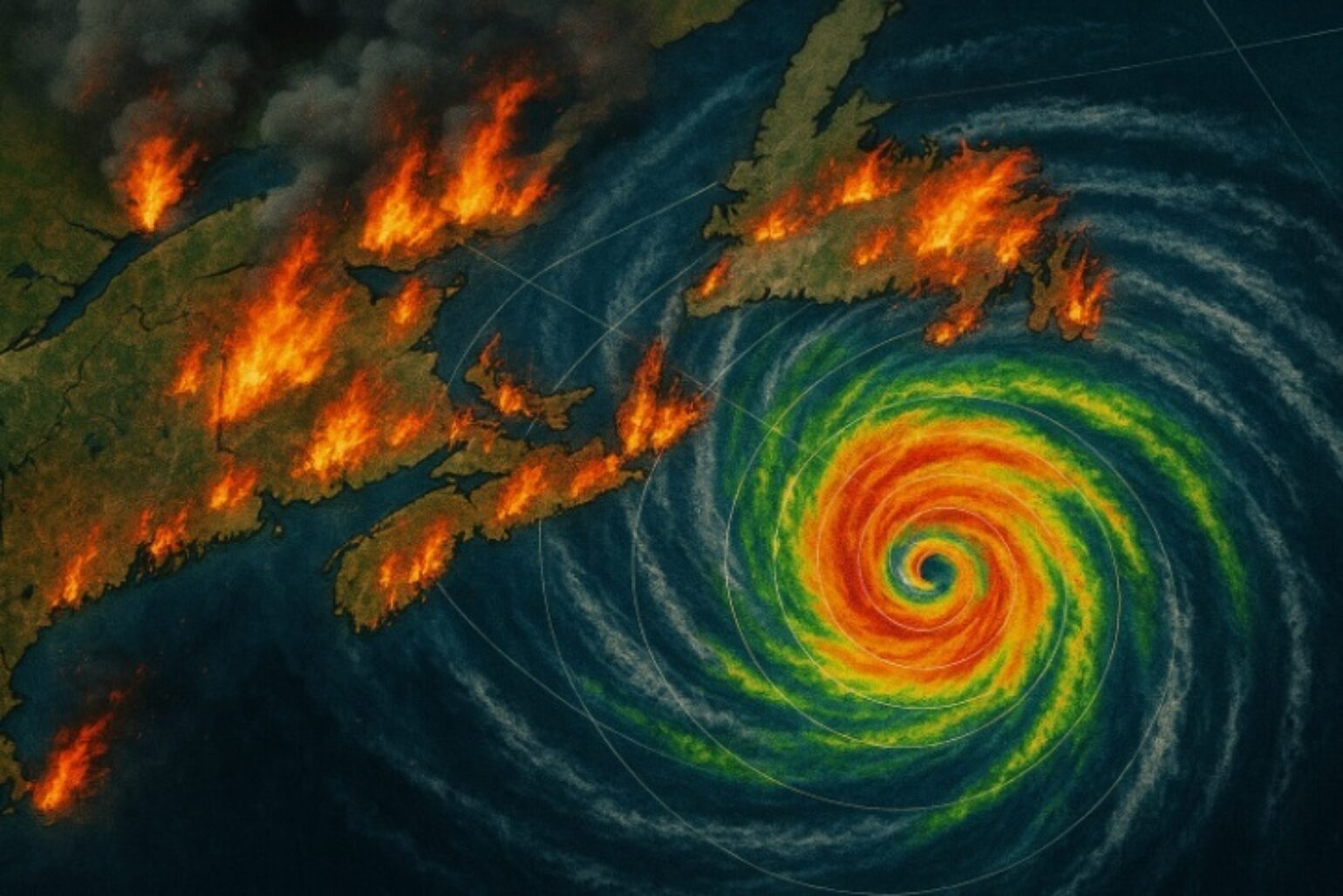
A Gray Swan Scenario for Atlantic Canada
For Nova Scotia, New Brunswick, and Prince Edward Island, a scenario where Hurricane Erin passes offshore without delivering significant rainfall could be a Gray Swan event, as the alignment of conditions —critically dry fuels, a human ignition source, and sustained high winds —could lead to a significant wildfire outbreak.
Insurers should view this as a test case in compound hazard readiness. This same scenario could play out across the U.S. as well. Think about the pine lands of New Jersey and a passing hurricane during dry conditions. While the probability of a large-scale wildfire outbreak from Erin may be low, the implications are worth noting: and time and time again, we have seen examples of where risk assessments need to include cross-hazard scenarios where one extreme event primes the conditions for another.
For now, the forecast remains hypothetical, with no current indications and long-range forecast uncertainty. It is hoped that Hurricane Erin will pass harmlessly offshore, remembered only for rough seas and breezy conditions.
